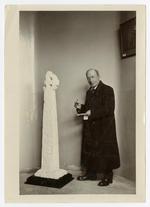The contents of this deposit consist of a wide variety of material that, not such as the papers of multiple Kermode family members. The remaining contents relay the career of PMC Kermode (PMCK), ranging from his professional career as an advocate to his career within Manx antiquities
Family papers
The contents of family papers of the Kermode family include the diaries of PMCK (1877-1932), sermons of his father William Kermode are included as are his notebooks, items on the Bishop of Sodor and Mann, pastoral work in his parish, correspondence to his wife and a registry of the congregation. Other items relate to PMCK's siblings such as printed poetry of Josephine 'Cushag' Kermode and her correspondence with PMCK and folklorist Sophia Morrison (1859-1917). Notebooks, diaries and account books of Caroline Matilda 'Cherril' Kermode (c.1861-1946) and a handwritten novel by Mary Anne 'Minnie Emily Kermode (b.1848) are present. Other journals, notebooks and exercise books including poetry and correspondence belong to William Kermode (b.1841) and Frederick Bishop Kermode (b.1849). Further items include various Kermode family correspondence and correspondence belonging to the Manx Museum's second director William Cubbon and Cherril Kermode after the death of PMC Kermode.
PMCK's correspondence
A large majority of the deposit is made of incoming (and some outgoing) correspondence of PMCK with correspondents' aphetically arranged. Examples such as Bishopscourt, linguist and runologist Erik Brate (1857-1924), William Cubbon (1865-1955), designer Archibald Knox (1864-1933) and Governor of the Isle of Man 1st Baron Loch (1827-1900). Other correspondents include the naturalist Cyril Ingram Paton (1874-1949), Governor of the Isle of Man Lord Raglan (1857-1921), naturalist Charles Swynnerton (1877-1938) and Manx language expert George William Wood (c.1852-1927). Further correspondence from societies or institutions includes the American Archaeological Society, Folklore, Isle of Man Government Office, Port Erin Biological Station, Royal Society of Antiquities of Ireland and the Viking Society.
PMCK's advocacy work
Papers, articles and correspondence relating to PMCK's advocacy work, his business with the Ramsey Town Commissioners, the Clerk to Justices, the Ramsey War Memorial and Ramsey Golf Club are present.
Archaeology and Natural History papers
Items relating to PMCK's work in archaeology of the Isle of Man consist of his archaeological notebooks and sketchbooks (an index was created by German archaeologist Maria Bersu [1902-1987]), items on runic inscriptions and crosses such as notebooks and illustrations. Also present is a proof book of Manx Crosses . Papers and notes on various topics include Norse inscriptions, the Sheadings of Mann, excavations, Archaeological Survey work, geology, ancient monuments, bronze implements, keeils, Manx antiquities and numismatics. Also included are illustrations of ancient English crosses. Documentation relating to Manx Natural history includes bird migration, insects ( Entomologia Manniae ), mammals and notes and correspondence concerning the Great Deer.
The Manx Museum and the National Trust of Ancient Monuments (MMNTAM) papers
Items present include papers, correspondence, catalogues, a museum diary and curator's book and printed material relating to the MMNTAM. Topics covered include the lobbying for the establishment of the Manx Museum and post 1922 work after the museum was created.
Publications and printed material
Folders of manuscript material on PMCK's Manx Antiquities (1914), Manx Crosses (1907), Traces of Norse Mythology in the Isle of Man (1904) plus reviews and articles of each publication are present. There are also numerous newspaper cuttings, printed material and printer proofs connected to the Manx Museum and Manx antiquities. Also included is printed material on non-Manx antiquities.

